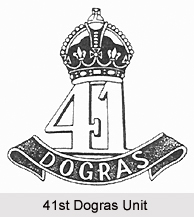 The 41st Dogras regiment was raised as an infantry unit that was formed in the year 1887 by the British East India Company. The battalion served the British administration till 1922. It was included as a part of the erstwhile Bengal Army under the Presidency Armies in British India. The infantry units of the army of Bengal Presidency were re-numbered several times. Later the regiment was incorporated into the Bengal Command. The infantry regiment was renamed as the 41st Dogra Infantry in the year 1901. After Indian independence, the military unit was apportioned to the Indian Army.
The 41st Dogras regiment was raised as an infantry unit that was formed in the year 1887 by the British East India Company. The battalion served the British administration till 1922. It was included as a part of the erstwhile Bengal Army under the Presidency Armies in British India. The infantry units of the army of Bengal Presidency were re-numbered several times. Later the regiment was incorporated into the Bengal Command. The infantry regiment was renamed as the 41st Dogra Infantry in the year 1901. After Indian independence, the military unit was apportioned to the Indian Army.
History of 41st Dogras
The 41st Dogras was raised in 1900 as the 41st (Dogra) Bengal Infantry regiment. The men of the unit were sent to China and became a part of an international force in the year 1904. The troops served in China till 1908. During the First World War, the infantry unit was stationed on the Western Front. Later the 41st Dogras regiment also served in the Mesopotamia Campaign under the British Indian Army. A second battalion of the regiment was founded in the year 1917.
The British authorities in India reformed the entire army after World War I. Consequently a number of multi battalion units comprising of 4 to 6 battalions were formed by joining together various single battalion infantry regiments. The 41st Dogras was developed as the 3rd and 10th Battalions 17th Dogra Regiment in 1922.
Development of 41st Dogras
After the withdrawal of the British Crown in India in the year 1947 and the Partition of India, the British Indian Army was divided along with the nation. The 41st Dogras regiment was assigned to the Union of India and the modern Indian Army.
Designations of 41st Dogras
The army unit held various titles and designations during it service under the British Indian Army. These are mentioned as follows -
* 41st (Dogra) Bengal Infantry (1900)
* 41st Dogra Infantry (1901)
* 41st Dogras (1903)
* 3rd and 10th Battalions 17th Dogra Regiment (1922)
* Assigned to Indian Army (1947)
This article is a stub. You may enrich it by adding more information to it. You can send your write-up at content@indianetzone.com



















